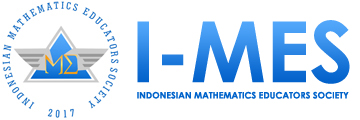Correction to: Constructing mathematical bitterness scale related to teacher factor
DOI:
https://doi.org/10.29408/jel.v11i3.32120Keywords:
correction, factor analysis, instrument, mathematical bitterness, quantitative, teacherAbstract
Correction to: Jurnal Elemen, Vol. 10 No. 2, May 2024, p. 395-409
https:/doi.org/10.29408/jel.v10i2.25508
The original version of this article unfortunately contained a mistake. The article contains a duplication of table numbers, specifically Table 2, resulting in a disruption of the sequential order of tables. Additionally, several citations are absent from the reference list, including Lima et al. (2019); McGee & Spencer (2021); Elliot & Bachman (2018); Durksen et al. (2017); Jais et al. (2019); Mammana & Pennisi (2011); Sierpinska et al. (2008); Heyder et al. (2019); and Carmichael et al. (2017). The original article has been corrected.
The original article can be found online at https://doi.org/10.29408/jel.v10i2.25508
References
Aguilar, J. J. (2021). High school students’ reasons for disliking mathematics: the intersection between teacher’s role and student’s emotions, belief and self-efficacy. International Electronic Journal of Mathematics Education, 16(3), em0658. https://doi.org/10.29333/iejme/11294
Almerino, Jr., P. M., Etcuban, J. O., De Jose, C. G., & Almerino, J. G. F. (2019). Students’ affective belief as the component in mathematical disposition. International Electronic Journal of Mathematics Education, 14(3), 475–487. https://doi.org/10.29333/iejme/5750
Amirali, M. (2010). Students’ conceptions of the nature of mathematics and attitudes towards mathematics learning. Journal of Research and Reflections in Education, 4(1), 27–41. https://ecommons.aku.edu/pakistan_ied_pdck/8
Anditya, R., & Murtiyasa, B. (2016). Faktor-faktor penyebab kecemasan matematika [Factors causing math anxiety]. Seminar Nasional Pendidikan Matematika, 1–8. https://publikasiilmiah.ums.ac.id/xmlui/bitstream/handle/11617/7611/25.Makalah_Rifin.pdf?sequence=1&isAllowed=y
Awofala, A. O. A., & Odogwu, H. N. (2017). Assessing preservice teachers’ mathematics cognitive failures as related to mathematics anxiety and performance in undergraduate calculus. Acta Didactica Napocensia, 10(2), 81–98. https://doi.org/10.24193/adn.10.2.7
Carmichael, C., Callingham, R., & Watt, H. M. G. (2017). Classroom motivational environment influences on emotional and cognitive dimensions of student interest in mathematics. ZDM - Mathematics Education, 49(3), 449–460. https://doi.org/10.1007/s11858-016-0831-7
Creswell, J. W. (2009). Research design (Qualitative, quantitative, and mixed methods approaches). In Muqarnas (3rd ed., Vol. 8). SAGE Publication Ltd. https://doi.org/10.1163/22118993-90000268
Creswell, J. W. (2014). Research design: Qualitative, quantitative, and mixed methods. Thousand Oaks, CA: Sage.
Dirgantoro, K. P. S., & Soesanto, R. H. (2021). Peran guru kristen dalam menuntun siswa memandang matematika [The role of christian teachers in guiding students to view mathematics]. JOHME: Journal of Holistic Mathematics Education, 5(1), 114–124. https://doi.org/10.19166/johme.v5i1.3363
Dirgantoro, K. P. S., Soesanto, R. H., & Yanti. (2023). A preliminary study on the formulation of indicators and definitions of mathematical bitterness related to teacher treatment. Jurnal Elemen, 9(1), 84–97. https://doi.org/10.29408/jel.v9i1.6637
Durksen, T. L., Way, J., Bobis, J., Anderson, J., Skilling, K., & Martin, A. J. (2017). Motivation and engagement in mathematics: A qualitative framework for teacher-student interactions. Mathematics Education Research Journal, 29(2), 163–181. https://doi.org/10.1007/s13394-017-0199-1
Elliott, L., & Bachman, H. J. (2018). How do parents foster young children’s math skills? Child Development Perspectives, 12(1), 16–21. https://doi.org/10.1111/cdep.12249
Estonanto, A. J. J., & Dio, R. V. (2019). Factors causing mathematics anxiety of senior high school students in calculus. Asian Journal of Education and E-Learning, 7(1), 37–47. https://doi.org/10.24203/ajeel.v7i1.5701
Fan, X., Hambleton, R. K., & Zhang, M. (2019). Profiles of mathematics anxiety among 15-year-old students: A cross-cultural study using multi-group latent profile analysis. Frontiers in Psychology, 10(May), 1–9. https://doi.org/10.3389/fpsyg.2019.01217
Gafoor, K. A., & Kurukkan, A. (2015a). Learner and teacher perception on difficulties in learning and teaching mathematics: Some implications. National Conference on Mathematics Teaching- Approaches and Challenges, 232–243. https://files.eric.ed.gov/fulltext/ED568368.pdf
Gafoor, K. A., & Kurukkan, A. (2015b). Why high school students feel mathematics difficult? An exploration of affective beliefs. UGC Sponsored National Seminar on Pedagogy of Teacher Education Trends and Challenges, August, 1–6. https://files.eric.ed.gov/fulltext/ED560266.pdf
Hair, J. F., Black, Jr, W. C., Babin, B. J., & Anderson, R. E. (2019). Multivariate Data Analysis (8th ed.). Pearson New International Edition.
Hannula, M. S., Kaasila, R., Pehkonen, E., & Laine, A. (2005). Structure and typical profiles of elementary teacher students’ view of mathematics. Proceedings of the 29th Conference of the International Group for the Psychology of Mathematics Education, 3(3), 89–96. https://www.emis.de/proceedings/PME29/PME29RRPapers/PME29Vol3HannulaEtAl.pdf
Hayati, Z., & Ulya, K. (2018). Are pupils scared of mathematics? A discussion on three strategies used in primary mathematics teaching. Proceedings of the International Conference on the Roles of Parents in Shaping Children’s Characters (ICECED), 107–114.
Hazimah, G. F., & Sutisna, M. R. (2023). Analisis faktor yang mempengaruhi rendahnya tingkat pemahaman numerasi siswa kelas 5 SDN 192 Ciburuy [Analysis of factors influencing the low level of numeracy understanding among fifth-grade students at SDN 192 Ciburuy]. El_Muhbib: Jurnal Pemikiran & Penelitian Pendidikan Dasar, 7(1), 10–19.
Heyder, A., Steinmayr, R., & Kessels, U. (2019). Do teachers’ beliefs about math aptitude and brilliance explain gender differences in children’s math ability self-concept? Frontiers in Education, 4(May), 1–11. https://doi.org/10.3389/feduc.2019.00034
Jailani, Retnawati, H., & Apino, E. (2020). High school students’ difficulties in making mathematical connections when solving problems. International Journal of Learning, Teaching and Educational Research, 19(8), 255–277. https://doi.org/10.26803/ijlter.19.8.14
Jais, E., Rezky, R., & Siombiwi, S. (2019). Analisis faktor-faktor penyebab timbulnya rasa takut siswa akan kegagalan dalam mempelajari matematika [Analysis of the factors causing students' fear of failure in learning mathematics]. Mandalika Mathematics and Educations Journal, 1(2), 95–103. https://doi.org/10.29303/jm.v1i2.1596
Kargar, M., Tarmizi, R. A., & Bayat, S. (2010). Relationship between mathematical thinking, mathematics anxiety and mathematics attitudes among university students. Procedia - Social and Behavioral Sciences, 8(5), 537–542. https://doi.org/10.1016/j.sbspro.2010.12.074
Larkin, K., & Jorgensen, R. (2015). ‘I hate maths: why do we need to do maths?’ Using ipad video diaries to investigate attitudes and emotions towards mathematics in year 3 and year 6 students. International Journal of Science and Mathematics Education, 14(5), 925–944. https://doi.org/10.1007/s10763-015-9621-x
Lima, P. D. S. N., Silva, L. D. A., Felix, I. M., & Brandao, L. D. O. (2019). Difficulties in basic concepts of mathematics in higher education: A Systematic Review. IEEE Frontiers in Education Conference (FIE). https://doi.org/10.1109/FIE43999.2019.9028658
Luttenberger, S., Wimmer, S., & Paechter, M. (2018). Spotlight on math anxiety. Psychology Research and Behavior Management, 11, 311–322. https://doi.org/10.2147/PRBM.S141421
Macmull, M. S., & Ashkenazi, S. (2019). Math anxiety: The relationship between parenting style and math self-efficacy. Frontiers in Psychology, 10, 1–12. https://doi.org/10.3389/fpsyg.2019.01721
Mammana, M. F., & Pennisi, M. (2011). A class practice to improve student’s attitude towards mathematics. Angewandte Chemie International Edition, 6(11), 951–952., 2, 395–398. https://slub.qucosa.de/api/qucosa%3A1782/attachment/ATT-0/
McGee, E., & Spencer, M. B. (2021). Black parents as advocates, motivators, and teachers of mathematics. The Mathematics Teacher, 41(6), 270–273. https://doi.org/10.5951/mt.41.6.0270
Mumcu, H. Y. (2018). Examining mathematics department students’ views on the use of mathematics in daily life. International Online Journal of Education and Teaching (IOJET), 5(1), 61–80.
Picker, S. H., & Berry, J. S. (2000). Investigating pupils’ images of Mathematicians. Educational Studies in Mathematics, 43(1), 65–94. https://doi.org/10.1023/A:1017523230758
Rizta, A., & Antari, L. (2018). Tingkat mathematics anxiety pada mahasiswa calon guru matematika. Jurnal Pendidikan Matematika, 13(1), 9–20. https://doi.org/10.22342/jpm.13.1.6827.9-20
Scarpello, G. (2007). Helping students get past math anxiety. Association for career and technical education. https://doi.org/10.1126/science.237.4822.1556
Sierpinska, A., Bobos, G., & Knipping, C. (2008). Sources of students’ frustration in pre-university level, prerequisite mathematics courses. In Instructional Science, 36(4). https://doi.org/10.1007/s11251-007-9033-6
van Brummelen, H. W. (2015). Berjalan bersama Tuhan di dalam kelas (Ke-3) [Walking with God in the Classroom (Part 3)]. ACSI.
Downloads
Published
How to Cite
Issue
Section
License
Copyright (c) 2025 Kurnia Putri Sepdikasari Dirgantoro, Robert Harry Soesanto, Yanti

This work is licensed under a Creative Commons Attribution-ShareAlike 4.0 International License.
Authors who publish with the Jurnal Elemen agree to the following terms:
- Authors retain copyright and grant the journal right of first publication with the work simultaneously licensed under Creative Commons Attribution-ShareAlike 4.0 International License (CC BY-SA 4.0).
- Authors are able to enter into separate, additional contractual arrangements for the distribution of the journal's published version of the work (e.g., post it to an institutional repository or publish it in a book), with an acknowledgment of its initial publication in this journal.
- Authors are permitted and encouraged to post their work online (e.g., in institutional repositories or on their website) prior to and during the submission process, as it can lead to productive exchanges, as well as earlier and greater citation of published work.
Jurnal Elemen is licensed under a Creative Commons Attribution-ShareAlike 4.0 International License





